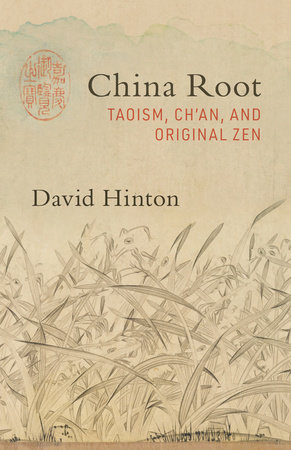Review: In China Root:
Taoism, Ch’an, and Original Zen by David Hinton
Rachel Hilton assesses David Hinton's new book which argues that Zen schools have a greater debt to Taoism than previously realised in the West. The author takes a philological journey into the problem of translating Chinese characters into Western languages.

China Root book cover
David Hinton is an American poet and translator who studied Chinese at Cornell University and in Taiwan. In China Root: Taoism, Ch’an, and Original Zen he explores the adventure of Ch’an (Zen) Buddhism, as originally practiced in ancient China.
The traditional view is that Buddhism originated in India, passed through China, where it underwent significant development, before moving on to Japan where it became known as Zen, the Japanese pronunciation of Ch’an, before finally arriving in the West. Western Zen Buddhism is thus firmly rooted in Japanese tradition, incorporating Japanese renderings of the names of Chinese Ch’an masters and of important terms such as kensho, koan, satori and mu.
Hinton turns this view on its head, arguing that, although Buddhism was indeed brought to China by Buddhist monks from India during the latter part of the Han dynasty (c. 150 CE), taking over a century to become assimilated into Chinese culture, during that time it was fundamentally reinterpreted and reshaped by Taoist thought, so much so that it was ultimately scarcely recognisable as Buddhism at all. Hence ancient China’s artist-intellectual class saw Ch’an as a refinement and extension of Taoism rather than as a school of Buddhism.
Given that Hinton is a translator, a great deal of his argument is philological. He argues that Sanskrit terms were poorly translated into Chinese using characters borrowed from the existing Taoist vocabulary, which continued to mean what they meant for Taoists, thus transforming Indian Buddhist concepts into Taoist concepts. Furthermore he points out that, because Chinese is not alphabetic, word for word translation was impossible. Instead Sanskrit terms had to be transliterated with Chinese ideograms having a similar sound, and, as each available sound can be used to pronounce many different ideograms, there were many choices for each Sanskrit term requiring transliteration. Thus ancient Chinese scholars were able to make choices within their own Taoist philosophical framework, adding Taoist dimensions to the original Indian concepts.
The majority of the book develops this argument by explaining important Zen concepts such as Meditation, Buddha, Empty-Mind, or Dharma, both from a Buddhist and from a Taoist perspective, through a series of short chapters each devoted to a single concept, often beginning by exploring the evolution of the pictographic element that represents that concept, from the simplified picture of ancient oracle bone script through to the more stylised compound characters of the present day. One quibble I have is that the selection of these specific concepts is not explained, nor why they are rather perplexingly grouped into three sections, without sub-headings.
What follows however is a fascinating account of how the native conceptual framework of Ch’an in ancient China was lost during Ch’an’s migration from China through Japan to the West, so that English translations of Ch’an literature hugely overlook Ch’an’s Taoist heritage. This is further explored in a substantial Appendix that compares the author’s own translations of original Ch’an texts with the standard translations that have shaped contemporary Zen to show in detail how Ch’an’s conceptual framework is fundamentally misrepresented or simply lost in translation.
For example, the Chinese character “wu”, (Japanese “mu”) is usually translated simply as “no” or “not”, but Hinton explains that “wu” is also the character for the Taoist elemental principle of “absence”, which is virtually synonymous with both Tao itself and also with “emptiness” in both Taoist and Ch’an texts. Thus, when Master Joshu says ”wu” in answer to the question of whether a dog has Buddha nature, he is not merely denying it, but also pointing to the Tao and its undivided wholeness.
I have a few reservations about the book. Firstly, it is quite scholarly and hence rather a challenging read, and I am not ashamed to say that I spent some time with a dictionary to better understand some of Hinton’s terminology. Therefore, it is not a book that is easy to dip in and out of. Secondly, and importantly, there are very few references and no index, so you are constantly flicking to and fro to work out who is speaking when quotations are given, or if you need to retrace your steps. Lastly, and for me this is a source of significant vexation, the names of well-known Zen masters are translated into the English meaning of the Chinese characters that compose their names, rather than retaining their Chinese or Japanese transliterations. For example, he refers to Master Joshu as “Master Visitation Land,” Master Rinzai as “Master Purport Dark Enigma” and Master Obaku as “Master Yellow-Bitterroot Mountain.” This would be fine if there were a glossary or appendix so that one could easily cross-reference these names with the names one is already familiar with, but without that it is very frustrating.
Despite these reservations, I found this book to be both valuable and insightful. I was fascinated by the exploration of the history and meaning of the Chinese characters used to express Ch’an ideas, and can better appreciate the contribution of Taoist concepts to modern Zen practice. Most importantly I now have some insight into why one finds an occasional lack of synergy between Zen teachings and those of other Buddhist schools.
Visiting Hunger Mountain with David Hinton




